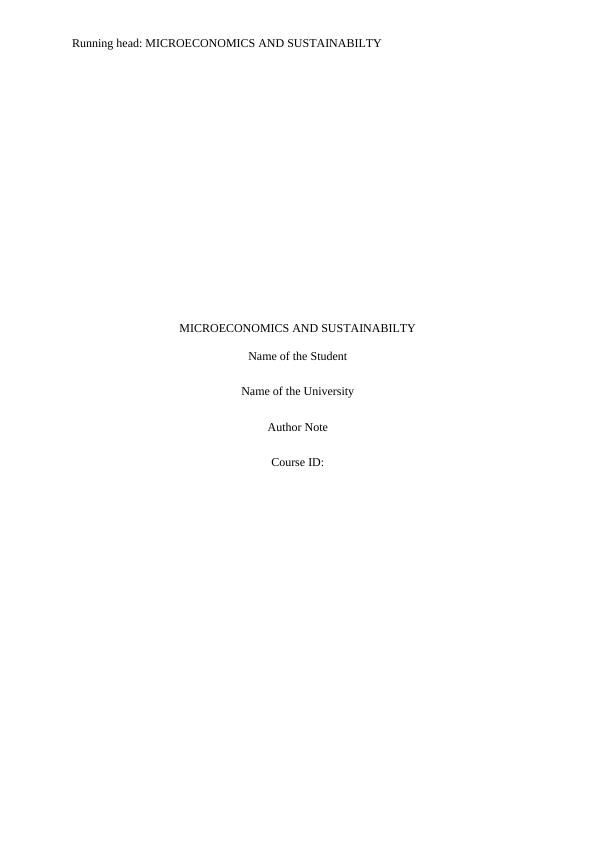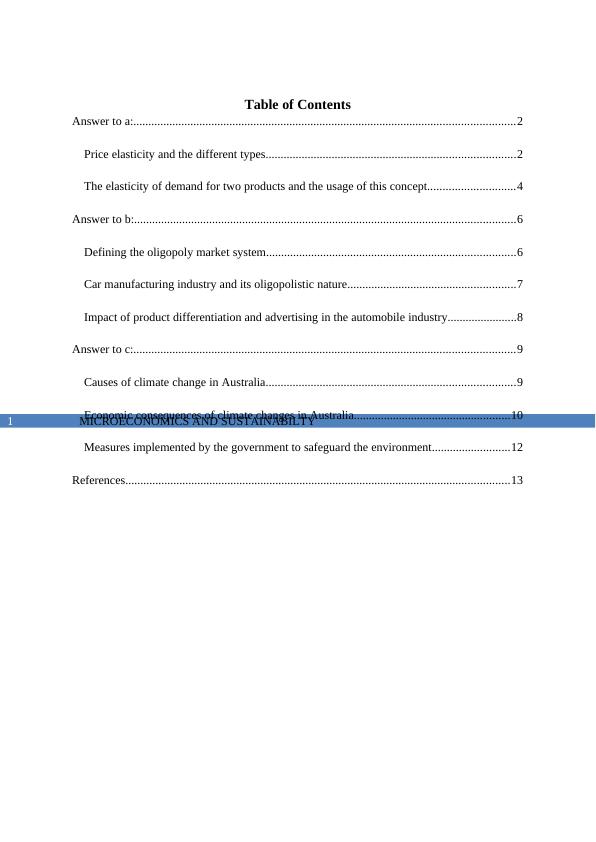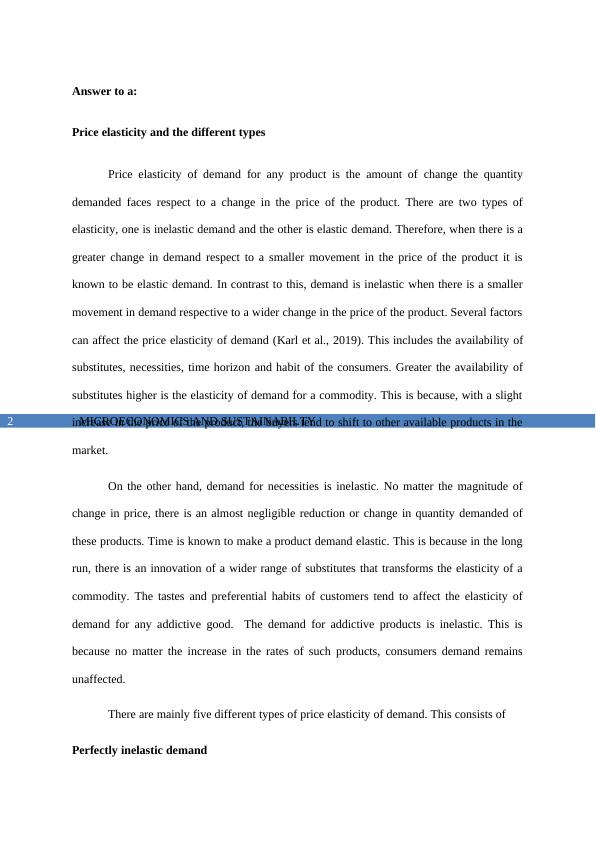Towards a Microeconomics for Ecological
Added on 2022-09-01
17 Pages3878 Words17 Views
Running head: MICROECONOMICS AND SUSTAINABILTY
MICROECONOMICS AND SUSTAINABILTY
Name of the Student
Name of the University
Author Note
Course ID:
MICROECONOMICS AND SUSTAINABILTY
Name of the Student
Name of the University
Author Note
Course ID:

MICROECONOMICS AND SUSTAINABILTY1
Table of Contents
Answer to a:...............................................................................................................................2
Price elasticity and the different types...................................................................................2
The elasticity of demand for two products and the usage of this concept.............................4
Answer to b:...............................................................................................................................6
Defining the oligopoly market system...................................................................................6
Car manufacturing industry and its oligopolistic nature........................................................7
Impact of product differentiation and advertising in the automobile industry.......................8
Answer to c:...............................................................................................................................9
Causes of climate change in Australia...................................................................................9
Economic consequences of climate changes in Australia....................................................10
Measures implemented by the government to safeguard the environment..........................12
References................................................................................................................................13
Table of Contents
Answer to a:...............................................................................................................................2
Price elasticity and the different types...................................................................................2
The elasticity of demand for two products and the usage of this concept.............................4
Answer to b:...............................................................................................................................6
Defining the oligopoly market system...................................................................................6
Car manufacturing industry and its oligopolistic nature........................................................7
Impact of product differentiation and advertising in the automobile industry.......................8
Answer to c:...............................................................................................................................9
Causes of climate change in Australia...................................................................................9
Economic consequences of climate changes in Australia....................................................10
Measures implemented by the government to safeguard the environment..........................12
References................................................................................................................................13

MICROECONOMICS AND SUSTAINABILTY2
Answer to a:
Price elasticity and the different types
Price elasticity of demand for any product is the amount of change the quantity
demanded faces respect to a change in the price of the product. There are two types of
elasticity, one is inelastic demand and the other is elastic demand. Therefore, when there is a
greater change in demand respect to a smaller movement in the price of the product it is
known to be elastic demand. In contrast to this, demand is inelastic when there is a smaller
movement in demand respective to a wider change in the price of the product. Several factors
can affect the price elasticity of demand (Karl et al., 2019). This includes the availability of
substitutes, necessities, time horizon and habit of the consumers. Greater the availability of
substitutes higher is the elasticity of demand for a commodity. This is because, with a slight
increase in the price of the product, the buyers tend to shift to other available products in the
market.
On the other hand, demand for necessities is inelastic. No matter the magnitude of
change in price, there is an almost negligible reduction or change in quantity demanded of
these products. Time is known to make a product demand elastic. This is because in the long
run, there is an innovation of a wider range of substitutes that transforms the elasticity of a
commodity. The tastes and preferential habits of customers tend to affect the elasticity of
demand for any addictive good. The demand for addictive products is inelastic. This is
because no matter the increase in the rates of such products, consumers demand remains
unaffected.
There are mainly five different types of price elasticity of demand. This consists of
Perfectly inelastic demand
Answer to a:
Price elasticity and the different types
Price elasticity of demand for any product is the amount of change the quantity
demanded faces respect to a change in the price of the product. There are two types of
elasticity, one is inelastic demand and the other is elastic demand. Therefore, when there is a
greater change in demand respect to a smaller movement in the price of the product it is
known to be elastic demand. In contrast to this, demand is inelastic when there is a smaller
movement in demand respective to a wider change in the price of the product. Several factors
can affect the price elasticity of demand (Karl et al., 2019). This includes the availability of
substitutes, necessities, time horizon and habit of the consumers. Greater the availability of
substitutes higher is the elasticity of demand for a commodity. This is because, with a slight
increase in the price of the product, the buyers tend to shift to other available products in the
market.
On the other hand, demand for necessities is inelastic. No matter the magnitude of
change in price, there is an almost negligible reduction or change in quantity demanded of
these products. Time is known to make a product demand elastic. This is because in the long
run, there is an innovation of a wider range of substitutes that transforms the elasticity of a
commodity. The tastes and preferential habits of customers tend to affect the elasticity of
demand for any addictive good. The demand for addictive products is inelastic. This is
because no matter the increase in the rates of such products, consumers demand remains
unaffected.
There are mainly five different types of price elasticity of demand. This consists of
Perfectly inelastic demand

MICROECONOMICS AND SUSTAINABILTY3
Under a perfectly inelastic demand, there is no change in the quantity demanded of a
good concerning any change in price. The demand curve is a vertical straight line, which
reflects a constant demand for a product. Therefore, if there is an increase in price, the total
revenue tends to rise (Chan & Gillingham, 2015).
Inelastic demand
Inelastic demand occurs when the change in price is more compared to the change in
quantity demanded of a product. Let us consider an example where there is about 15 percent
increase in the price of the product corresponding to about 7 percent fall in demand. This is
because the slope of the demand curve is steep. Therefore, with an increase in price, the total
revenue of a firm tends to rise.
Unitary elastic demand
Amount of a product demanded is said to be unitary elastic when there is an equal
amount of changes in demand and price of a product. Therefore, with an increase in the rate
of the good, the total revenue remains unaffected.
Perfectly elastic demand
In a perfectly elastic demand, a slight increase in price leads to a negligible fall in
quantity demanded. Whereas, with a slight fall in the price, the rise in demand is infinite. In
this, the demand curve is horizontal to the x-axis. With a change in price, there is negligible
change in total revenue.
Elastic demand
Elastic demand is characterised by a large change in quantity demand corresponding
to a smaller change in demand. If there is a 7 percent increase in price, then the quantity
Under a perfectly inelastic demand, there is no change in the quantity demanded of a
good concerning any change in price. The demand curve is a vertical straight line, which
reflects a constant demand for a product. Therefore, if there is an increase in price, the total
revenue tends to rise (Chan & Gillingham, 2015).
Inelastic demand
Inelastic demand occurs when the change in price is more compared to the change in
quantity demanded of a product. Let us consider an example where there is about 15 percent
increase in the price of the product corresponding to about 7 percent fall in demand. This is
because the slope of the demand curve is steep. Therefore, with an increase in price, the total
revenue of a firm tends to rise.
Unitary elastic demand
Amount of a product demanded is said to be unitary elastic when there is an equal
amount of changes in demand and price of a product. Therefore, with an increase in the rate
of the good, the total revenue remains unaffected.
Perfectly elastic demand
In a perfectly elastic demand, a slight increase in price leads to a negligible fall in
quantity demanded. Whereas, with a slight fall in the price, the rise in demand is infinite. In
this, the demand curve is horizontal to the x-axis. With a change in price, there is negligible
change in total revenue.
Elastic demand
Elastic demand is characterised by a large change in quantity demand corresponding
to a smaller change in demand. If there is a 7 percent increase in price, then the quantity

End of preview
Want to access all the pages? Upload your documents or become a member.
Related Documents
Microeconomic Conceptslg...
|8
|1485
|157
Microeconomicslg...
|12
|2457
|268
Economics Assignment: Price Elasticity of Demand and Trade Protectionismlg...
|9
|2332
|431
Understanding Price Elasticity of Demand and the Impact of Protectionist Policies on Australian Businesseslg...
|22
|5373
|370
Microeconomics - Price Elasticity of Demandlg...
|5
|778
|11
Economics of Managers Question Answer 2022lg...
|21
|4495
|20
